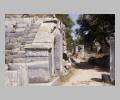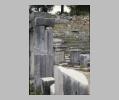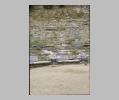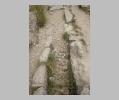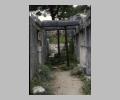| Context: | Priene |
| Type: | Theater |
| Summary: | Theater of Greek type with orchestra, parodoi, and stage building, located in the north of the city, below the acropolis and above the upper gymnasium. |
| Date: | ca. 300 BC - ca. 200 AD |
| Dimensions: | Greatest diameter of orchestra 18.65 m.; length of stage building 18.41 m. Total height of proscenium 2.70 m.; Doric order of proscenium: width of triglyphs 0.18 m.; width of metopes 0.28 m.; height of triglyph frieze 0.29 m; width of podium (logeion) 2.74 m. Width of staircases ca. 0.92 m. Height of seats 0.40 m. Width of passageway between orchestra and first row of seats ca. 1.82 m. |
| Region: | Ionia |
| Period: | Hellenistic/Roman |
Architectural Order:
Doric. The facade of the proscenium was articulated by Doric half-columns engaged to rectangular piers, supporting an architrave and Doric frieze.
Plan:
The auditorium was greater than a semi-circle, with stone parodos walls. Seating consisted of five cunei of seats with six staircases, with 22 tiers of seats in the lower story and 25 in the upper. The stage building was rectangular and two-storied; in front of it stood the proscenium, which was slightly longer than the stage building itself. The facade of the proscenium was articulated by a one-storied row of pillars with eleven intercolumniations. From the proscenium cross-beams ran back to the stage building to support the flat wooden roof.
Date Description:
Although different building phases are clear, their dates remain controversial. The influence of New Comedy on stage design is cited to support the date of the construction of the stage building and its logeion; the evidence of statue bases and their inscriptions, dedicated in front of the proscenium, has been cited to provide a terminus ante quemfor the construction of the proscenium. The presence of Roman building techniques (rubble masonry, mortar, plastered walls etc.) dates the reconstruction of the stage building.
History:
The building history of the theater at Priene spans a number of centuries. Sometime after the refounding of the city (ca. 350 B.C.), the seats of the auditorium and the central orchestra were prepared (ca. 300 B.C.), at which time there may have been a temporary wooden stage building. In ca. 200 B.C. marble seats were added on the circumference of the orchestra; presumably the action still took place in the central orchestra at this time. In the mid-second century B.C., a change in the presentation of dramatic action, due to the influence of New Comedy, occurred: the roof of the proscenium became the "stage", instead of the central orchestra. Consequently, a stone proscenium was built at Priene in front of the stage building, which also was reconstructed in stone. The roof of the proscenium became the floor of the stage (the logeion), with the action taking place in front of the upper story of the stage building (the episcenium). At this period the episcenium was opened up with three large doors (thyromata) to accommodate the actors and hold stage scenery. Statue bases dating to ca. 135 B.C. in front of the proscenium provide a terminus ante quem for the construction of this feature. Marble benches were constructed higher up in the auditorium, to afford a better view of the action. To the late Hellenistic period should also be ascribed the walling-up of the intercolumniations of the proscenium; painted panels hung here. In the Roman Imperial period, in the second century A.D., the stage building was further articulated with a two-story facade with three doors and two niches.
Other Notes:
Dating questions: an early document from the city, dated to ca. 330 B.C. refers to seating rights; some have assumed that therefore the theater must have been laid out by this time. Von Gerkan, however, prefers a date of ca. 300-250 B.C., based on his study of the stage building. Von Gerkan had argued that the proscenium was part of the original structure of the theater, but such an early appearance of this feature is not only unparalleled but also not supported by the archaeological evidence. The proscenium at Priene must represent a later addition. A nicety of design of the theater at Priene is the fact that the face of the proscenium stylobate coincides with the side of a theoretical square inscribed within the circle created by the orchestra, as prescribed by Vitruvius in his description of the Greek theater. (Vitruvius De Arch. 5.7.1).A marble rectangular altar was found in the orchestra, near its circumference; it is decorated with an Ionic entablature, and carried the inscription:
Numerous traces of polychromy indicate that the individual elements of the proscenium were painted with blue and red.
Sources Used:
